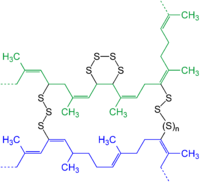
Photo from wikipedia
A facile route for the preparation of core cross-linked polymeric micelles via self-complementary multiple hydrogen bonds was developed. Double hydrophilic block copolymers of poly(ethylene glycol)-b-poly(N-isopropylacrylamide) (PEG-b-PNIPAm), with 2-ureido-4[1H]-pyrimidinone (UPy) functionality… Click to show full abstract
A facile route for the preparation of core cross-linked polymeric micelles via self-complementary multiple hydrogen bonds was developed. Double hydrophilic block copolymers of poly(ethylene glycol)-b-poly(N-isopropylacrylamide) (PEG-b-PNIPAm), with 2-ureido-4[1H]-pyrimidinone (UPy) functionality throughout PNIPAm block, were synthesized via reversible addition–fragmentation chain transfer polymerization. It was found that the strong dimerization of the self-complementary quadruple hydrogen-bonding UPy groups could induce non-covalent intermolecular bonding between the copolymer chains and serve as core cross-linking of the formed micelles. The stability and thermo-responsive properties of the obtained micelles with varying UPy side-group content were investigated by dynamic light scattering, atomic force microscopy and fluorescence spectroscopy. The PNIPAm core of the cross-linked micelles exhibits reversible thermo-responsive swelling/shrinking behavior, as evident from the hydrodynamic diameter changes detected during cyclic heating-cooling tests. The thermo-responsive loading and release of pyrene molecules (as a model hydrophobic drug) demonstrate a potential application of the synthesized core cross-linked micelles in controlled drug delivery. The results indicate that multiple hydrogen-bonding interactions between UPy moieties can be maintained in a hydrophilic aqueous environment, which provides a convenient approach to stabilize the micellar structures and maintain responsive behaviors of double hydrophilic block copolymers by core cross-linking. This work provides new insights into designing stable and stimuli-responsive polymer micelles with a wide range of applications in drug delivery, diagnosis and sensing.
Journal Title: Polymer Chemistry
Year Published: 2017
Link to full text (if available)
Share on Social Media: Sign Up to like & get
recommendations!